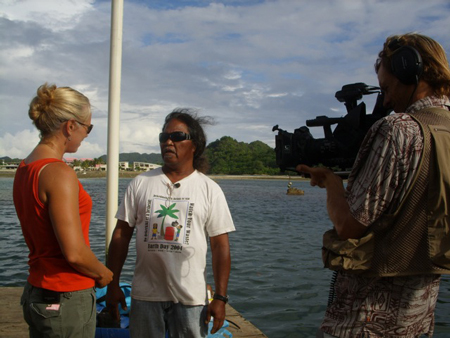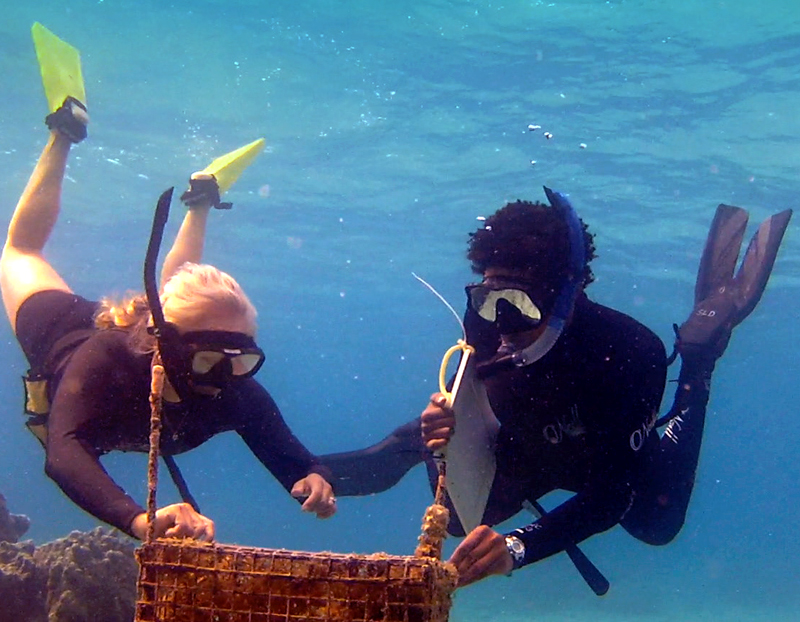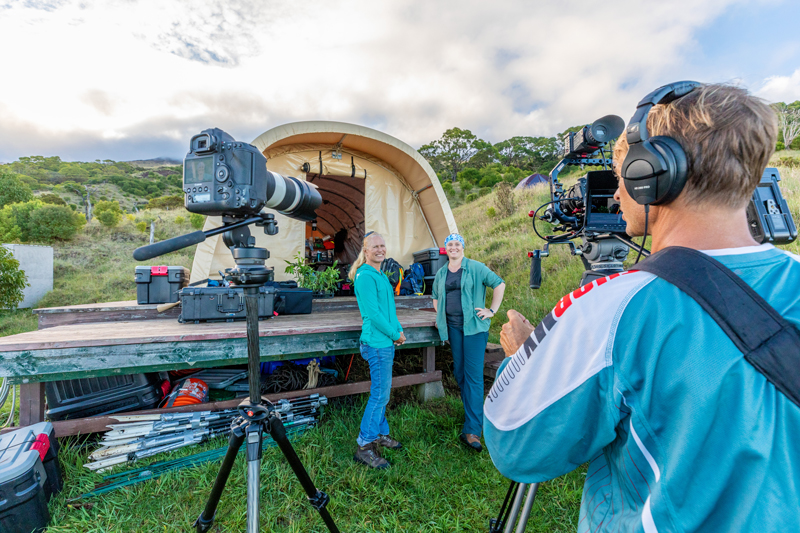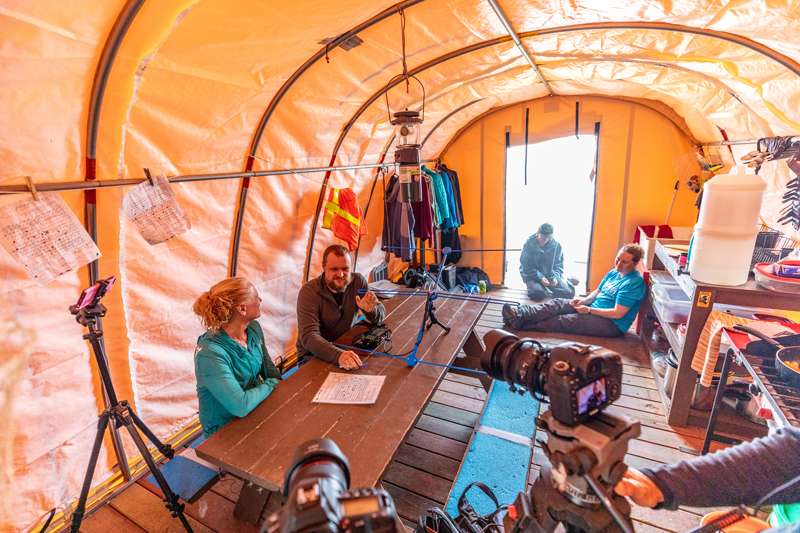The importance of communicating science to the public is being increasingly recognized in light of ongoing climate change, the COVID-19 pandemic, and many other issues affecting everyday people. However, most current outreach endeavors—science days, open houses, podcasting, and the like—skew heavily toward middle- and upper-class audiences.
Even the Internet is not universal. As of April 2020, 59% of people around the world actively use the Internet [Statista, 2020]. This figure is higher in the United States, but 27% of Americans still lack high-speed Internet access, and access is not uniform across demographics. Forty-four percent of U.S. households earning less than $30,000 per year lack high-speed Internet compared with just 8% of households making more than $75,000 per year. The disparities are similar among groups of different educational levels and are more pronounced among various ethnic groups, in Black and Hispanic communities, and in rural areas [Pew Research Center, 2019].

To promote diversity, equity, and inclusion in the geosciences, researchers as well as science communicators need to engage in expanding public perceptions of who does research and how research is conducted, provide connections to local role models for people interested in geoscience careers, and pursue outreach geared toward underrepresented segments of the population. Voice of the Sea, a series of half-hour television episodes now in its seventh year, is attempting to do just that, using a tried-and-true medium that continues to attract large audiences over a broad demographic spectrum.
Television: Where the Audience Is
Reaching underrepresented groups requires looking outside the traditional academic sphere to both novel approaches and existing mediums. Television (TV), for example, remains an effective tool. Despite perceptions among most of my academic friends about it being outmoded, TV is still the most used media platform in the United States. In 2019, Nielsen [2019] reported that Americans watched more than 4 hours of TV daily, with viewing times ranging from 22% of daily media time for young adults (ages 18–34) up to 58% for adults over 65 years.
During the current pandemic, TV viewing for entertainment and education has increased, both in the United States and globally.
During the current pandemic, TV viewing for entertainment and education has increased, both in the United States [Nielsen, 2020a] and globally [Mueller and Taj, 2020], raising its relative importance in delivering information. Indeed, TV is a primary source of reliable information for vast segments of the population. Some 65% of surveyed Hawaii residents, for example, reported TV to be the most reliable source of information about important issues facing their communities. This percentage was similar to that reported for newspapers (61%) and far outdistanced social media (26%), radio (19%), and word of mouth (15%) [Ward Research, 2014]. This trust in TV media makes it a valuable resource for sharing important science and cultural information.
The Power of a Good Video
Words are powerful conveyors of information. However, when it comes to communicating complex topics like climate change, video is superior to text [Goldberg et al., 2019]. The reasons for video’s effectiveness in science communication are not fully understood but may relate to high production value, imagery that helps familiarize concepts and link ideas to real life, and viewers visually witnessing scientists agreeing with other experts’ findings [Goldberg et al., 2019].
Increasing awareness of science, technology, engineering, and mathematics (STEM) careers through video can improve the accuracy of students’ perceptions and increase their desire to pursue STEM careers [Wyss et al., 2012]. Moreover, once created, video products can be shared directly in classrooms, education centers, and libraries; online via social media, websites, and streaming services; and on TV and can even be adapted for podcasts.

Authentic Science Stories, in Depth
In 2009, when my colleagues suggested that we propose to develop a TV series as a companion to a high school marine science curriculum in Hawaii, I jumped at the chance. I wanted to tell authentic science stories through a pedagogical lens using educational research about the way people learn.
Even as flashy, attention-grabbing content has become increasingly needed to penetrate social media markets, TV has proven to be a stable platform useful in addressing equity issues in science.
Still, I wondered if my efforts would be better spent working on short, 15- to 30-second pieces focused on interesting facts about marine science. Indeed, some grant reviewers felt that the public would not be willing to watch half-hour episodes devoted to topics like plankton, jellyfish, and aquaponics. The consensus is shifting, however, as the public’s appetite for long-form, informational media, like podcasts, is growing—and projected to double in popularity by 2023 [Nielsen, 2020b]. Thus, even as flashy, attention-grabbing content has become increasingly needed to penetrate social media markets, TV has proven to be a stable platform useful in addressing equity issues in science.
Now in its seventh TV season, more than 100 original episodes of Voice of the Sea have aired. A series of surveys with 650 viewer respondents has shown that a broad cross section of them gained significant content knowledge after watching an episode of the show. They also reported increases in interest, understanding, and motivation [Duncan Seraphin et al., 2017].
Each episode of Voice of the Sea is broadcast twice weekly on TV in Hawaii and is viewed by more than 25,000 people [Marshall Marketing, 2019]. Most viewers are homeowners (50%–60%), female (70%–80%), non–college educated (70%–80%), and local (90%–100% have lived in Hawaii for more than 16 years) [Marshall Marketing, 2017].
We also air in other regions of the Pacific: Guam, Palau, Micronesia, and American Samoa. Although viewership in the outer Pacific is less studied, we know there are fewer TV channels in these areas (and thus fewer programs from which to choose), so a higher percentage of the 300,000 people living in these regions probably views our programming.
Since 2014, we have won 30 national Telly Awards for educational TV programming, including a Gold award in 2020 for our episode about Export Processes in the Ocean from Remote Sensing (EXPORTS), the joint National Science Foundation and NASA project to model carbon sequestration in the deep sea. (The publicity trailer for this episode appears below.)

Our online presence is newer: We first started putting episodes online in 2017. Since then, we have built a following of 4,000 YouTube subscribers, a social media presence, and a website, where each episode is paired with additional content and student activities.
Scientists Help Tell Their Stories Well
Researchers and educators typically leave video and television stories about science to production and marketing professionals. The resulting glossy products may have high production value, but they usually fall short in terms of accuracy, authenticity, and complexity. So often, TV producers focus on the story to the exclusion of the science.
My own experience reflects this. While I was in graduate school, my lab studied large predatory fishes, primarily sharks and tunas, and was frequently filmed for national TV programs. I regularly saw my work distorted in these portrayals.
In one documentary, our work tagging sharks was paired with video of people frolicking on a beach to build a sense of danger and fear among viewers, despite our study site being nowhere near the beach. In another documentary, the narrator said that I “cut off the shark’s clasper—that’s shark talk for penis” to perform genetic analysis. In reality, I had taken a small piece of tissue from the neighboring pelvic fin, but that fact did not enter the story—or stop the throng of emails from concerned viewers who had watched the show!
Moreover, typical TV science focuses on a limited range of topics, like charismatic megafauna (e.g., elephants, pandas, and polar bears) and catastrophic natural hazards. While I spent the early 2000s being filmed for my work on hammerhead and tiger sharks, my ichthyologist colleagues studying tidepool blennies and cryptic, sand-dwelling gobies waited for their phones to ring.

By engaging in video and episode development, researchers can shape story narratives, ensuring that end products are accurate and meaningful. Finding a compelling narrative to begin with is a key early step in this process, and it can be challenging. But honestly, there are so many excellent stories out there—of who scientists are, how they got interested in research, what their work is really like, and what has surprised them—that finding suitable narratives has become one of the more enjoyable aspects of my work. And there are many models, coaches, seminars, and workshops to help hone science storytelling.
I try to approach Voice of the Sea episodes from an educational and communications perspective. I believe researchers can help showcase diversity in their ranks and promote real-life heroes to stimulate even more diversity in the next generation of scientists by involving ourselves in the production of media and TV related to our areas of interest and study.
Nuts and Bolts of TV and Media Production
Make no mistake, however, TV production is hard work. Voice of the Sea ultimately provides free, high-quality, ready-to-air content to TV stations, but for those of us behind the show—and, indeed, for most educational science programming—securing funding is an ongoing issue, on top of the many challenges of planning, filming, and assembling episodes. The main expenses in our production include filming, editing, graphics, and associated travel; other costs include those for closed captioning, translation (e.g., to Hawaiian, Samoan, and Spanish), and subtitling to extend our reach online and in science centers.

We have had success winning funds from local foundations and through small grants to produce episodes about specific topics. But most of our funding for the past four seasons has come by way of “broader impacts and outreach” components of research grants awarded to scientists whose work we cover in Voice of the Sea episodes. Although we do not have the capacity to sell commercial spots for the Voice of the Sea series, commercials may be a potential revenue stream to offset production costs for other such TV projects.
Partnering with a production company or a university media department is arguably the most feasible way to create longer science-focused content for TV (i.e., 30- to 60-minute episodes). Such content can then be broadcast on local, public, or university-run TV stations that are often willing to take one-off specials but that may not have available airtime in their broadcast schedule for a whole series. Finding a home station for a regular (e.g., weekly) TV series is more difficult and usually requires production of a pilot or test episode and the guarantee of at least 12 to 19 new episodes per year.
Local Science, Coming to a TV Near You
Regional TV episode production could be useful as a means of outreach and a way for communities to learn about science research happening where they live.
Voice of the Sea is in good company on TV. The U.S. Public Broadcasting Service works with K–12 students to produce programming for local channels, like HIKI NŌ in Hawaii, which offer opportunities for researchers to share their science. There are a handful of dedicated, regional science TV series as well. In Puerto Rico, for example, TV viewers can watch GeoAmbiente, a Spanish language series that shares information about local science and conservation efforts.
New series are also being developed. The University of Rhode Island’s Inner Space Center, for example, which produces video and provides telepresence connectivity on oceanographic research cruises, has been working to extend their resources to deliver content in TV-friendly packages. This type of regional TV episode production has the potential to be useful at many universities and research institutions across the country as a means of outreach and a way for communities to learn about science research happening where they live (see video below). In fact, one of the most common requests that the Voice of the Sea team receives is by people asking us to make an episode about what is happening at a particular reef, beach, or stream that’s near them or about which they care especially.

Making this type of connection to place elevates the value of, and the opportunities provided by, regional TV to share local research with local stakeholders—to profile science role models who look and talk like their viewers do. By increasing exposure to potential opportunities and relatable role model connections, we move closer to increased diversity, equity, and inclusion across scientific disciplines.
Acknowledgments
The Voice of the Sea series is produced through the University of Hawaiʻi Sea Grant, in collaboration with Kauai Sound and Cinema Media Corporation, Aberdeen Broadcast Services, and the experts profiled in each episode, who provide critical knowledge, images, and video to tell their stories. Video clips are provided courtesy of Voice of the Sea.
References
Duncan Seraphin, K., et al. (2017), Using TV to teach ocean science and promote STEM careers across the Pacific: Voice of the Sea, Current, 31, 30–35.
Goldberg, M. H., et al. (2019), The experience of consensus: Video as an effective medium to communicate scientific agreement on climate change, Sci. Commun., 41, 659– 673, https://doi.org/10.1177/1075547019874361.
Marshall Marketing (2017), Hawaiʻi market survey, Honolulu.
Marshall Marketing (2019), Hawaiʻi market survey, Honolulu.
Meuller, B., and M. Taj (2020), Struggling under lockdown, schools worldwide relearn the value of TV: In New Jersey, Tanzania, Peru, TV lessons replace online learning, New York Times, 20 Aug., www.nytimes.com/2020/08/17/world/coronavirus-television-schools.html.
Nielsen (2019), The Nielsen total audience report Q3 2018, New York.
Nielsen (2020a), Staying put: Consumers forced indoors during crisis spend more time on media, New York, www.nielsen.com/us/en/insights/article/2020/staying-put-consumers-forced-indoors-during-crisis-spend-more-time-on-media/.
Nielsen (2020b), Podcast content is growing audio engagement, New York, www.nielsen.com/us/en/insights/article/2020/podcast-content-is-growing-audio-engagement/.
Pew Research Center (2019), Mobile technology and home broadband 2019, Washington, D.C., www.pewresearch.org/internet/2019/06/13/mobile-technology-and-home-broadband-2019/.
Statista (2020), Global digital population as of April 2020, New York, statista.com/statistics/617136/digital-population-worldwide/#statisticContainer.
Ward Research (2014), Water pricing survey, Hawai‘i Commun. Found. and Fresh Water Counc., Honolulu.
Wyss, V. L., D. Heulskamp, and C. J. Siebert (2012), Increasing middle school student interest in STEM careers with videos of scientists, Int. J. Environ. Sci. Educ., 7, 501–522.
Author Information
Kanesa Duncan Seraphin ([email protected]), Hawaiʻi Sea Grant, School of Ocean and Earth Science and Technology, University of Hawaiʻi at Mānoa, Honolulu
Citation:
Duncan Seraphin, K. (2021), A tried-and-true medium to broaden the reach of science, Eos, 102, https://doi.org/10.1029/2021EO153261. Published on 11 January 2021.
Text © 2021. The authors. CC BY-NC-ND 3.0
Except where otherwise noted, images are subject to copyright. Any reuse without express permission from the copyright owner is prohibited.

